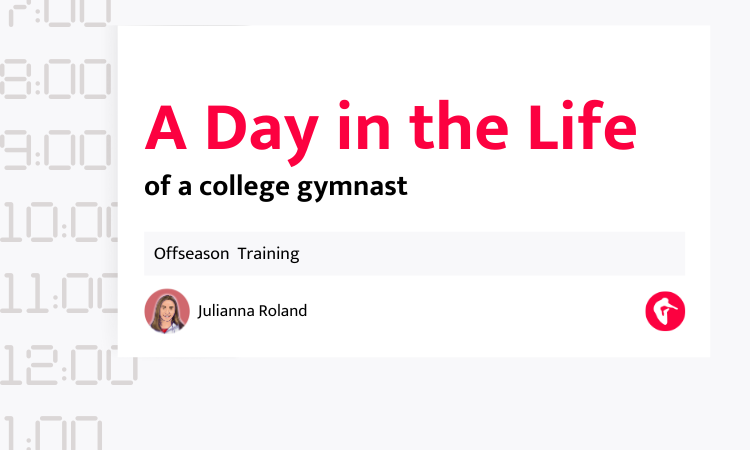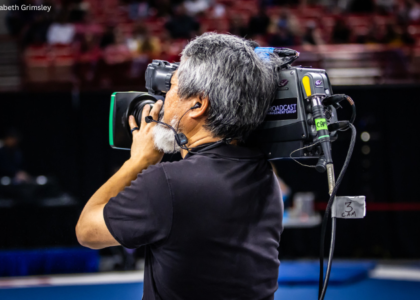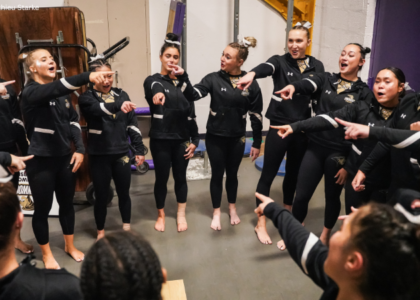My name is Julianna Roland, and I am a recent graduate from Temple University. I finished my college gymnastics career at Temple, but I began at the University of Bridgeport five years ago. Since I was two years old in mommy and me classes, gymnastics has been my life. This year will be the first time ever that my afternoons won’t consist of going to practice, and my January to April won’t be filled with sparkly leotards, travel meet bus trips, or braiding hair every weekend.
Having recently retired from the sport, I knew I would have to give up on the physical part of the sport, but I wasn’t necessarily ready to be done with the whole sport yet. Being close to the sport for so long, I am here to provide the scoop from the inside!
What should you expect in this “Day in the Life” series? The expectations placed on college gymnasts in all aspects of their lives from the season to the time outside of it.
For this first edition, I’m going over unofficial and official practice. What does summer training look like? What is expected of you coming back to campus? Every year is different, and every person’s experience is unique, but with this series, I’m hoping to provide some insight from my point of view.
When the season comes to an end, not having a set schedule is definitely difficult. Returning to your club gym to train for the summer usually means training by yourself for a handful of hours a week, recovering from the previous season, and taking the much-needed “you time” to head into the next preseason prepared. Training in the summer is certainly less demanding than the season (it has to be to make it through the next season!), but nevertheless, there are clear expectations as to what your gymnastics and overall physical capabilities should look like when you come back to campus in three short months.
When you leave for the summer, you get a packet that serves as a guide for June to August. In my own experiences with two different programs, the summer plan has been relatively the same. Each person has their events ranked by priority for what to keep as their main focus while training over the summer. For example, my priority list my final year was 1. vault, 2. beam and floor, without bars listed since I thankfully retired from the event after an unfortunate incident where I bit through my mouth on a Ray my junior year (a story for another time). These event rankings for each gymnast are ordered either by what they contributed to the previous season or the events the coaches feel like they should be working to compete the next season.
Perhaps the most daunting part of the packet was the skills portion. While I can’t speak for the experience of all college gymnasts, I think for the most part we all had some rendition of this section for summer training. For me, after each event was ranked, there were clear expectations for the skills I should have or the major things I should be working on by the time I come back to campus.
Similar to the ranking of events, the skills you’re expected to have, whether it be maintaining old ones or working on new ones, is based on a couple different things. These expectations come from what you did the previous season, building on the capabilities you have already shown. For example, this may look like “work on landings on first pass on floor, build up endurance on bars,” and other similar goals.
On the other hand, these skill expectations might be based on what you didn’t do, which can be much scarier. For example, this may say something like, “be ready to compete a Yurchenko one and a half by season, upgrade beam series from back handspring layout step-out to back handspring layout step-out layout step-out” or other similar goals. These might be skills you did five years ago during your first year of level 10 when you were being recruited, a skill you have never done, or where the coaches anticipate there will be holes in the team’s lineup during the upcoming season due to graduating gymnasts, possible transfers, etc.
Nevertheless, whatever goals are outlined in your packet, whether they all be purely maintenance or you are expected to come back with almost an entirely new skill set, the time frame when you’ll be tested on how successful you were in completing the packet is the same as your teammates.
The summer for college gymnasts, and honestly college athletes in general, can really be described as a double-edged sword in a couple of ways. On one hand, you just went through months of vigorous competition, traveling every weekend for three months, and you really do need the summer to reset, relax, and recover. However, you are also presented with these expectations for the next year, sometimes with some sort of ultimatum attached, depending on your previous year’s contributions, and the anxiety about fulfilling these goals comes creeping in pretty early.
Offseason and summer training is really circumstantial; you might have had surgery post-season, you might not have a gym to train at over the summer, you might have a really exciting vacation you’ve been planning since January, or you might being starting to feel your age (personally, I didn’t realize my body wasn’t still an 18-year-old freshman!). But in only a few short months, regardless of what you did last season, what you did over the summer, or how the team now looks, everyone is in the same boat.
That’s what I’ll get into in the next edition of A Day in the Life.
READ THIS NEXT: Recruiting Declassified: Recruiting Calls
Article by Julianna Roland
Like what you see? Consider donating to support our efforts throughout the year!





2 comments